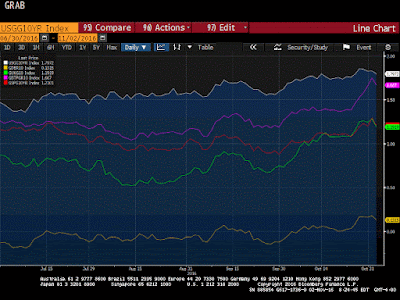US Political Anxiety Stems Bond Sell-Off
 One of the most significant market developments has been the rising bond yields. This has now been checked by the risk aversion spurred by new narrowing of the odds of a Clinton victory.
One of the most significant market developments has been the rising bond yields. This has now been checked by the risk aversion spurred by new narrowing of the odds of a Clinton victory.
The US 10-year yield had risen from below 1.32% on July 6 to a high last week and again yesterday just below 1.88%. It tested 1.78% today, just after of the 20-day moving average. The December note futures is rising about the steep downtrend line formed in October that was found near 130-00. Technical indicators suggest additional near-term gains are likely. There is a bullish divergence in the MACDs. The first target is 130-16 and then 131-00.
However, as this Great Graphic from Bloomberg shows, European bond yields have also been rising. The white line in the US 10-year yield. Italy is just below it in purple. Spain's 10-year yield is represented by the red line, which has converged with the UK in green. The yellow line at the bottom is Germany's 10-year yield.
The German yield set the record low near minus 20 bp on in early-July. By late-September, the yield was still at a lowly minus 15 bp. It was briefly traded above 20 bp yesterday. It has slipped to almost 11bp earlier today.
The UK yield bottomed on the anniversary of the end of Bretton Woods and India's independence (August 15) at 50 bp. At the end of last week, it poked above 1.30%. The rising UK yield may reflect two considerations. The first is compensation for investors to ostensibly offset some currency risk. The second is to compensate for rising inflation expectations.
Italian 10-year bond yield also bottomed in mid-August. The yield had risen from 1.03% to 1.77% yesterday. It is now about 10 bp below the high water mark. Between October 25 and November 1, Italy's 10-year bond yield rose by more than 45 bp. Italy is caught up in the global development but also has some unique negatives. Recall that Sentix found more investors think Italy is more likely to leave the monetary union then Greece. In addition, there is much angst over next month's referendum. Also, even before the latest earthquakes, the Italian government was at odds with the EC over the FY17 budget.
Spain's 10-year yield has also increased, but the move was considerably more restrained. The yield did not bottom until early October (~86 bp). It rose to a high of 1.31 yesterday and today. Spain is also resisting pressure from the EC on the budget. Deflationary forces are abating, and the economy remains among the strongest in the region.
The rise in yields seems to be driven by two main considerations. First, there is growing evidence that deflationary forces have abated in Europe and the US. Second, the long-end of the US and European bond markets are highly correlated regarding direction, though not magnitude. The rise in the US (and UK yields) would likely exert upward pressure on other European yields in any event.
The increase in the UK and EMU bond yields is a good reminder that simply because officials are purchasing bonds, the yields do not necessarily fall. This was also the US experience. Bond yields would fall ahead of the implementation of the asset purchases and then often rise during the official purchases.
This post was originally published by Marc Chandler at his blog, marctomarket.com
Copyright © Marc Chandler















